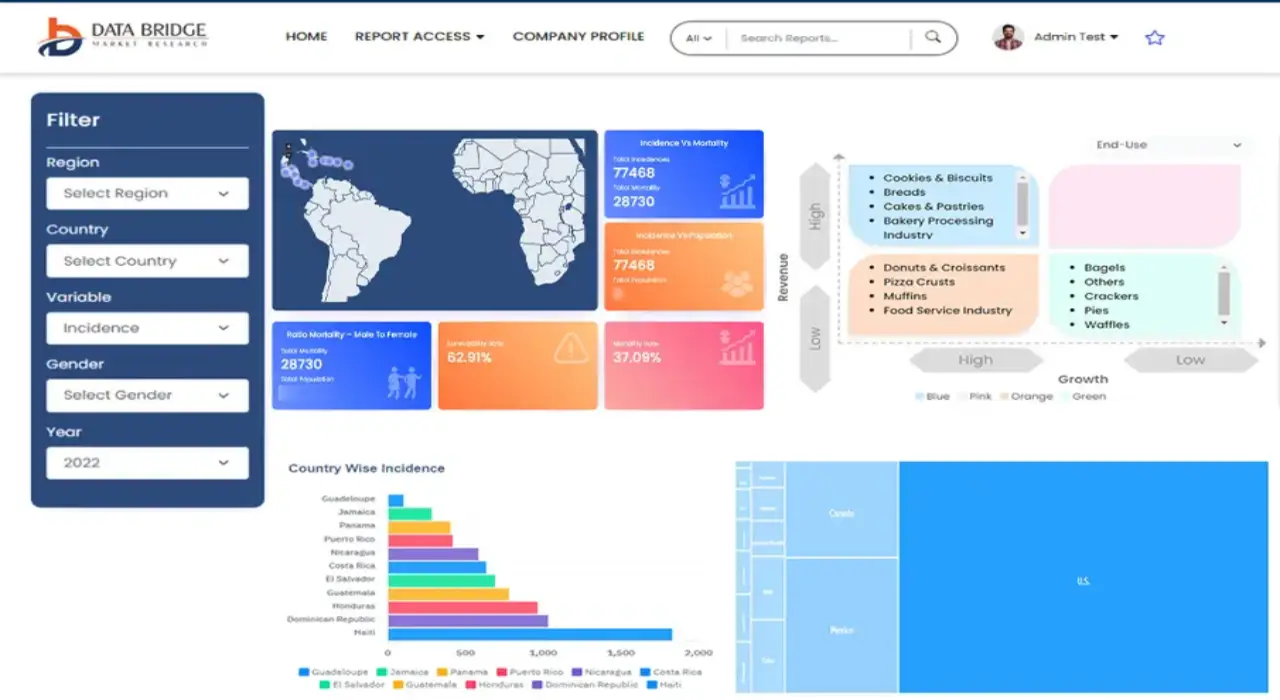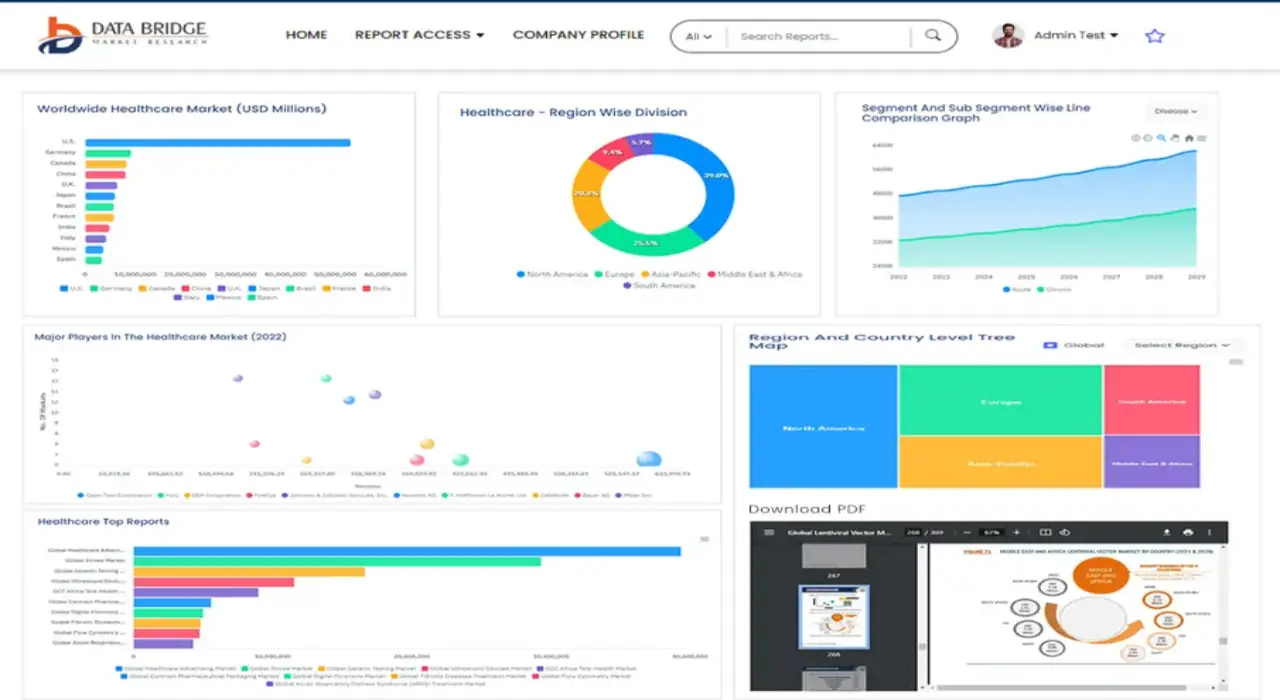Global Home Health Hub Market
시장 규모 (USD 10억)
연평균 성장률 :
% 
 USD
445.65 Million
USD
1,395.84 Million
2023
2031
USD
445.65 Million
USD
1,395.84 Million
2023
2031
| 2024 –2031 | |
| USD 445.65 Million | |
| USD 1,395.84 Million | |
|
|
|
>Global Home Health Hub Market Segmentation, By Product/ Services (Smartphone-Based, Standalone, and Services), Patient Monitoring (High-Acuity Patient Monitoring, Moderate-Acuity Patient Monitoring, and Low-Acuity Patient Monitoring), End User (Hospitals, Healthcare Payers, and Home Care Agencies) – Industry Trends and Forecast to 2031
Home Health Hub Market Analysis
The global home health hub market has gained momentum due to advancements in telehealth, connected medical devices, and the drive toward personalized care. Increasing demand for remote patient monitoring, spurred by an aging population and the prevalence of chronic diseases, fuels the adoption of these platforms, which aggregate health data from various devices to deliver comprehensive insights. Growth is further propelled by technological improvements and investment in health IT, while barriers include cybersecurity concerns and regulatory challenges. Key players are focusing on interoperability and patient engagement to stay competitive. Moreover, the ongoing COVID-19 pandemic has accelerated the adoption of home health solutions, as more patients seek safe alternatives to in-person visits. With the increasing prevalence of chronic diseases and the aging population, the home health hub market is poised for further expansion, offering numerous opportunities for stakeholders to improve patient outcomes and optimize healthcare delivery.
Home Health Hub Market Size
The global home health hub market size was valued at USD 445.65 million in 2023 and is projected to reach USD 1395.84 million by 2031, with a CAGR of 15.34% during the forecast period of 2024 to 2031. In addition to the insights on market scenarios such as market value, growth rate, segmentation, geographical coverage, and major players, the market reports curated by the Data Bridge Market Research also include depth expert analysis, patient epidemiology, pipeline analysis, pricing analysis, and regulatory framework.
Home Health Hub Market Trends
“Rising Integration of Artificial Intelligence (AI) and Machine Learning Technologies”
A significant trend in the home health hub market is the integration of artificial intelligence (AI) and machine learning technologies to enhance remote patient monitoring and care coordination. AI-driven platforms are now capable of analyzing data from various connected devices to provide personalized health insights, enabling timely interventions. For instance, systems can predict potential health issues based on user data patterns, improving outcomes for chronic conditions such as diabetes and heart disease. This trend boosts efficiency and empowers patients by providing real-time feedback on their health, leading to better engagement and adherence to treatment plans. As telehealth continues to evolve, AI integration will play a crucial role in shaping the future of home health care.
Report Scope and Home Health Hub Market Segmentation
|
Attributes |
Home Health Hub Key Market Insights |
|
Segments Covered |
|
|
Countries Covered |
U.S., Canada and Mexico in North America, Germany, France, U.K., Netherlands, Switzerland, Belgium, Russia, Italy, Spain, Turkey, Rest of Europe in Europe, China, Japan, India, South Korea, Singapore, Malaysia, Australia, Thailand, Indonesia, Philippines, Rest of Asia-Pacific (APAC) in the Asia-Pacific (APAC), Saudi Arabia, U.A.E., South Africa, Egypt, Israel, Rest of Middle East and Africa (MEA) as a part of Middle East and Africa (MEA), Brazil, Argentina and Rest of South America as part of South America |
|
Key Market Players |
AMC Health (U.S.), Cambridge Consultants (U.K.), Capsule Technologies Inc. (U.S.), eDevice (France), Pfizer Inc. (U.S.), Inhealthcare (U.K.), Qualcomm Technologies, Inc. (U.S.), Encompass Health Corporation (U.S.), Honeywell International Inc. (U.S.), MyVitalz, Inc. (U.S.), Koninklijke Philips N.V. (Netherlands), HiCare Services Pvt. Ltd (India), INiTSiator GmbH (Germany), Resideo Technologies Inc. (U.S.), Optum, Inc. (U.S.), OnKöl (U.S.), and MeKo Manufacturing e.K. (Germany) |
|
Market Opportunities |
|
|
Value Added Data Infosets |
In addition to the insights on market scenarios such as market value, growth rate, segmentation, geographical coverage, and major players, the market reports curated by the Data Bridge Market Research also include depth expert analysis, patient epidemiology, pipeline analysis, pricing analysis, and regulatory framework. |
Home Health Hub Market Definition
A home health hub is a centralized platform that integrates various digital health monitoring devices and telehealth technologies, allowing for remote patient care and management. It facilitates the collection and analysis of health data from connected devices, enabling healthcare providers to monitor patients' conditions in real-time, provide timely interventions, and enhance overall care coordination. These hubs are particularly beneficial for managing chronic diseases and improving patient engagement by empowering individuals with personalized health insights and resources
Home Health Hub Market Dynamics
Drivers
- Increasing Aging Population
The aging population is a significant market driver for home health services, as the number of individuals aged sixty-five and older is projected to increase dramatically. According to the U.S. Census Bureau, the population of seniors in the U.S. is expected to reach around 88 million by 2025, nearly doubling from the 53 million recorded in 2020. This demographic shift creates an urgent need for long-term care solutions that allow seniors to receive medical attention and support within the comfort of their homes. As a result, home health services are increasingly being viewed as essential components of healthcare systems, fostering a growing demand for innovative home health hubs that can cater to the unique needs of this population segment.
- Rising Preference for Home Care Among Patients
The preference for home care among patients is a significant driver of the home health hub market, as many individuals express a strong desire to receive care in the comfort of their own homes rather than in traditional clinical settings. For instance, organizations such as Caring.com are developing comprehensive home health platforms that facilitate telehealth consultations, remote monitoring, and medication management, ensuring patients receive the necessary care without the need for frequent hospital visits. As healthcare providers adapt to meet the changing preferences of patients, the demand for home health hubs continues to rise, creating a lucrative market opportunity for companies that can offer effective, patient-centered home care solutions. This shift improves patient satisfaction and aligns with the broader movement towards value-based care, emphasizing outcomes and patient experience.
Opportunities
- Rising Costs of Hospital Stays and Institutional Care
Rising healthcare costs represent a significant market opportunity for home health hubs, as the increasing expenses associated with hospital stays and institutional care are prompting both patients and healthcare systems to seek more cost-effective home care solutions. For instance, a report from the American Hospital Association indicates that the average cost of a hospital stay has risen considerably over the past decade, leading patients to explore alternatives that offer both quality care and financial savings. Home health hubs, which integrate various health monitoring devices and telehealth services, provide a viable solution by allowing patients to receive care in the comfort of their homes at a fraction of the cost of traditional inpatient services. This shift helps reduce the financial burden on patients and alleviates pressure on healthcare systems facing overcrowding and rising operational costs. As the demand for affordable healthcare options continues to grow, the home health hub market stands to benefit significantly, offering innovative solutions that align with the needs of patients and providers alike.
- Rising Focus on Preventive Care and Early Intervention
The increased focus on preventive care and early intervention represents a compelling market opportunity for home health hubs, which can play a crucial role in facilitating regular health monitoring and timely medical interventions. As healthcare systems shift towards models that prioritize prevention over treatment, home health hubs provide a platform for continuous health tracking, enabling patients to identify potential health issues before they escalate. For instance, devices integrated into home health hubs can monitor vital signs such as heart rate, blood pressure, and glucose levels, alerting healthcare providers when abnormalities are detected. Companies such as Fitbit Health Solutions are developing systems that track health metrics and connect patients with healthcare professionals for proactive consultations based on their monitored data. This capability enhances patient engagement and encourages adherence to preventive measures, ultimately leading to better health outcomes and reduced healthcare costs. As the healthcare landscape increasingly values preventive care, the demand for innovative home health hubs that support these initiatives is likely to grow, providing a significant opportunity for market players to innovate and expand their offerings.
Restraints/Challenges
- Workforce shortages of Skilled Professionals
Workforce shortages pose a significant challenge to the home health sector, particularly in the availability of skilled professionals, which can directly affect the quality of care provided and limit the capacity to meet the growing demand for home health services. According to a report from the American Hospital Association, the healthcare industry is expected to face a shortage of nearly 3.2 million healthcare workers by 2026, with home health aides and nurses being among the most critically needed positions. This challenge is further exacerbated by the demanding nature of home health work, which can lead to burnout and high turnover rates among staff. As a result, the inability to adequately staff home health services can hinder the effectiveness of home health hubs, as fewer professionals are available to provide necessary monitoring and interventions, ultimately hampering the overall growth of the market.
- Data Security and Privacy
Data security and privacy have become critical challenges for the home health sector, particularly with the increased use of digital health solutions and home health hubs that collect and transmit sensitive patient information. As healthcare providers implement telehealth platforms and remote monitoring systems, concerns about the security of electronic health records (EHRs) and personal health data have intensified. A report from the Office of the National Coordinator for Health Information Technology indicates that healthcare data breaches affected approximately 45 million individuals in recent years, highlighting the vulnerability of patient information in the digital landscape. Such breaches compromise patient privacy and lead to significant legal and financial repercussions for providers. Consequently, hindering the overall growth of the market.
This market report provides details of new recent developments, trade regulations, import-export analysis, production analysis, value chain optimization, market share, impact of domestic and localized market players, analyses opportunities in terms of emerging revenue pockets, changes in market regulations, strategic market growth analysis, market size, category market growths, application niches and dominance, product approvals, product launches, geographic expansions, technological innovations in the market. To gain more info on the market contact Data Bridge Market Research for an Analyst Brief, our team will help you take an informed market decision to achieve market growth.
Home Health Hub Market Scope
The market is segmented on the basis of product/services, patient monitoring, and end user. The growth amongst these segments will help you analyse meagre growth segments in the industries and provide the users with a valuable market overview and market insights to help them make strategic decisions for identifying core market applications.
Product/Services
- Smartphone-Based
- Standalone
- Services
- Remote Patient Monitoring Services
- Support and Maintenance Services
Patient Monitoring
- High-Acuity Patient Monitoring
- Moderate-Acuity Patient Monitoring
- Low-Acuity Patient Monitoring
End User
- Hospitals
- Healthcare Payers
- Home Care Agencies
Home Health Hub Market Regional Analysis
The market is analysed and market size insights and trends are provided by country, product/services, patient monitoring, and end user as referenced above.
The countries covered in the market report are U.S., Canada and Mexico in North America, Germany, France, U.K., Netherlands, Switzerland, Belgium, Russia, Italy, Spain, Turkey, Rest of Europe in Europe, China, Japan, India, South Korea, Singapore, Malaysia, Australia, Thailand, Indonesia, Philippines, Rest of Asia-Pacific (APAC) in the Asia-Pacific (APAC), Saudi Arabia, U.A.E., South Africa, Egypt, Israel, Rest of Middle East and Africa (MEA) as a part of Middle East and Africa (MEA), Brazil, Argentina and Rest of South America as part of South America.
North America is projected to lead the home health hub market, largely due to its swift adoption of digital healthcare solutions and high rate of technological advancements. The region’s healthcare sector has seen substantial investment in digital health technologies, enabling more efficient, connected patient care and remote monitoring capabilities. Additionally, increased demand for patient-centered solutions and a strong infrastructure for telemedicine further solidify North America’s dominant position in this market. As digitalization continues to evolve, the region remains at the forefront of implementing innovative health technology solutions.
Asia-Pacific is anticipated to experience the highest growth rate in the home health hub market during the forecast period from 2024 to 2031. This rapid growth is driven by a surge in awareness around health and wellness, with more people prioritizing proactive health management and preventive care. Additionally, expanding healthcare infrastructure and increasing investments in digital health technologies across countries in the region are fueling demand for home health solutions. As interest in health innovation grows, Asia-Pacific is positioned as a key player in the global health market.
The country section of the report also provides individual market impacting factors and changes in regulation in the market domestically that impacts the current and future trends of the market. Data points such as down-stream and upstream value chain analysis, technical trends and porter's five forces analysis, case studies are some of the pointers used to forecast the market scenario for individual countries. Also, the presence and availability of global brands and their challenges faced due to large or scarce competition from local and domestic brands, impact of domestic tariffs and trade routes are considered while providing forecast analysis of the country data.
Home Health Hub Market Share
The market competitive landscape provides details by competitor. Details included are company overview, company financials, revenue generated, market potential, investment in research and development, new market initiatives, global presence, production sites and facilities, production capacities, company strengths and weaknesses, product launch, product width and breadth, application dominance. The above data points provided are only related to the companies' focus related to market.
Home Health Hub Market Leaders Operating in the Market Are:
- AMC Health (U.S.)
- Cambridge Consultants (U.K.)
- Capsule Technologies Inc. (U.S.)
- eDevice (France)
- Pfizer Inc. (U.S.)
- Inhealthcare (U.K.)
- Qualcomm Technologies, Inc. (U.S.)
- Encompass Health Corporation (U.S.)
- Honeywell International Inc. (U.S.)
- MyVitalz, Inc. (U.S.)
- Koninklijke Philips N.V. (Netherlands)
- HiCare Services Pvt. Ltd (India)
- INiTSiator GmbH (Germany)
- Resideo Technologies Inc. (U.S.)
- Optum, Inc. (U.S.)
- OnKöl (U.S.)
- MeKo Manufacturing e.K. (Germany)
Latest Developments in Home Health Hub Market
- In August 2024, A USD 14.28 million health hub in Bakewell, Derbyshire, is set to open on 23 September. The Newholme Health Centre will feature an ambulance station and offer NHS outpatient services, including physiotherapy and audiology. The facility has been constructed on the site of the former ambulance station and the adjacent Newholme Hospital, which is scheduled for decommissioning
- In April 2024, The Food and Drug Administration's (FDA) device center has launched an initiative to support the development of at-home medical devices, prioritizing health equity in home-based care. According to a spokesperson speaking with Fierce Healthcare, the FDA invested over a million in an initial partnership. Insights from this "Home as a Health Care Hub" initiative may shape future regulations and the technology utilized in hospital-at-home programs
- In January 2021, Philips strengthened its position in inpatient care management solutions for hospitals by acquiring Capsule Technologies, Inc
- In September 2020, Sensate Cybersecurity Solutions introduced a cybersecurity program specifically for critical access and rural hospitals, offering an integrated security platform that protects servers, networks, medical devices, and other related systems
- In March 2022, VEON Ltd., a global provider of connectivity and internet services, announced that its Bangladeshi mobile operator, Banglalink, launched Health Hub, the first comprehensive digital health platform in Bangladesh
SKU-
세계 최초의 시장 정보 클라우드 보고서에 온라인으로 접속하세요
- 대화형 데이터 분석 대시보드
- 높은 성장 잠재력 기회를 위한 회사 분석 대시보드
- 사용자 정의 및 질의를 위한 리서치 분석가 액세스
- 대화형 대시보드를 통한 경쟁자 분석
- 최신 뉴스, 업데이트 및 추세 분석
- 포괄적인 경쟁자 추적을 위한 벤치마크 분석의 힘 활용
연구 방법론
데이터 수집 및 기준 연도 분석은 대규모 샘플 크기의 데이터 수집 모듈을 사용하여 수행됩니다. 이 단계에는 다양한 소스와 전략을 통해 시장 정보 또는 관련 데이터를 얻는 것이 포함됩니다. 여기에는 과거에 수집한 모든 데이터를 미리 검토하고 계획하는 것이 포함됩니다. 또한 다양한 정보 소스에서 발견되는 정보 불일치를 검토하는 것도 포함됩니다. 시장 데이터는 시장 통계 및 일관된 모델을 사용하여 분석하고 추정합니다. 또한 시장 점유율 분석 및 주요 추세 분석은 시장 보고서의 주요 성공 요인입니다. 자세한 내용은 분석가에게 전화를 요청하거나 문의 사항을 드롭하세요.
DBMR 연구팀에서 사용하는 주요 연구 방법론은 데이터 마이닝, 시장에 대한 데이터 변수의 영향 분석 및 주요(산업 전문가) 검증을 포함하는 데이터 삼각 측량입니다. 데이터 모델에는 공급업체 포지셔닝 그리드, 시장 타임라인 분석, 시장 개요 및 가이드, 회사 포지셔닝 그리드, 특허 분석, 가격 분석, 회사 시장 점유율 분석, 측정 기준, 글로벌 대 지역 및 공급업체 점유율 분석이 포함됩니다. 연구 방법론에 대해 자세히 알아보려면 문의를 통해 업계 전문가에게 문의하세요.
사용자 정의 가능
Data Bridge Market Research는 고급 형성 연구 분야의 선두 주자입니다. 저희는 기존 및 신규 고객에게 목표에 맞는 데이터와 분석을 제공하는 데 자부심을 느낍니다. 보고서는 추가 국가에 대한 시장 이해(국가 목록 요청), 임상 시험 결과 데이터, 문헌 검토, 재생 시장 및 제품 기반 분석을 포함하도록 사용자 정의할 수 있습니다. 기술 기반 분석에서 시장 포트폴리오 전략에 이르기까지 타겟 경쟁업체의 시장 분석을 분석할 수 있습니다. 귀하가 원하는 형식과 데이터 스타일로 필요한 만큼 많은 경쟁자를 추가할 수 있습니다. 저희 분석가 팀은 또한 원시 엑셀 파일 피벗 테이블(팩트북)로 데이터를 제공하거나 보고서에서 사용 가능한 데이터 세트에서 프레젠테이션을 만드는 데 도움을 줄 수 있습니다.















